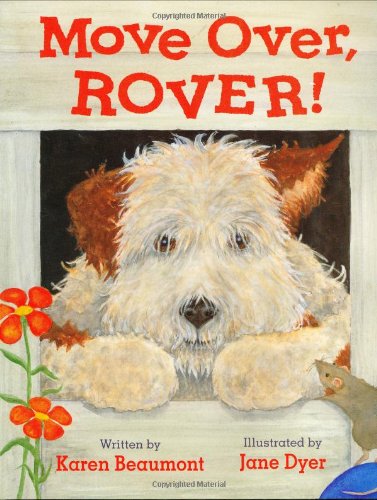 by Karen Beaumont
by Karen Beaumont
Rover is safe and dry inside his doghouse on a rainy day, until one by one creatures show up for shelter. But when unwelcome visitor Skunk joins in, suddenly that doghouse isn’t quite so crowded.
Strategies/Skills Used
Reading Strategy 1: Access background knowledge.
Reading Strategy 2: Predict what will be learned or what will happen.
Reading Strategy 7: Determine the most important ideas and events and the relationship between them.
Reading Strategy 9: Identify and interpret literary elements in different genres.
Reading Strategy 10: Summarize what has been read.
 TEACHING THE ACTIVITY: PRE-READING
TEACHING THE ACTIVITY: PRE-READING
(1) Pre-select a dog and a skunk (either stuffed animals or puppets) and one other prop from the story (e.g. dog’s dish, umbrella, doghouse, ball).
(2) Explain to the students that they are going to imagine and predict as a group what might happen if these things were together in one story.
(3) Introduce the Building From Clues process and invite students’ interactions with partners to imagine the possibilities.
(4) Explain that one student in the partnership will be reporting their group’s thinking. Facilitate student sharing of predictions.
 TEACHING THE ACTIVITY: DURING READING
TEACHING THE ACTIVITY: DURING READING
(5) Read the story Move Over, Rover! as an interactive read-aloud. Invite students’ choral response with repeating patterns of text and lyrical chants for each animal.
(6) Stop and recall the entry sequence of the animals at various points in the story.
(7) Question with students, “How and when did the skunk enter the doghouse?”
(8) As a class, review the story images from the beginning to find the skunk in every image. Discuss the importance of the images and how illustrators hide secrets for readers to discover and make inferences from.
 TEACHING THE ACTIVITY: POST-READING
TEACHING THE ACTIVITY: POST-READING
(9) Present a follow-up Story Board or Story Cycles activity that provides an opportunity for students to recall the sequence of events and retell or summarize the plot.
(10) Have early primary students collaborate in small groups with the animals and props to re-enact the sequence of events.